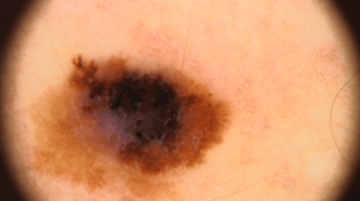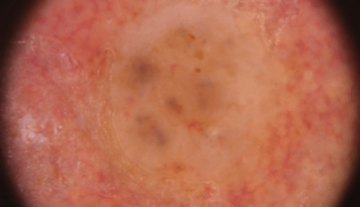Skin cancer
The skin is the largest organ of the human body, it protects your body from cold, infection and UV radiation. But it is also responsible for the production of vitamin D. That is why it is necessary to take care of it properly.
What can go wrong with the skin?
- eczema
- acne
- infection
- autoimmune
- inflammation
- cancer
What are the most common types of skin cancer?
- Basal cell carcinoma: this type of skin cancer is the most common and its incidence has doubled in the last 15 years. In 80% of cases it occurs on the head and neck.
- Melanoma: is a malignant tumor of pigment cells that occurs mainly on the skin, but can also appear under the nail or in the eye.
How does skin cancer manifest itself?
- Melanoma: is a malignant tumor of pigment cells that occurs mainly on the skin, but can also appear under the nail or in the eye. Melanoma usually looks like a strangely changing pigment mark that suddenly increases in size, has an irregular border and plays with different colors. We should pay attention if such a sign is larger than 6 mm.
- Other malignant tumors: At first glance, they appear inconspicuous and appear as a poorly healing ulcer that oozes, itches and may even bleed, or as a reddened deposit with a rough surface. They most often appear on the face, head and limbs, which are the places that are most exposed to sunlight.

Melanoma

How can I prevent this?
One of the main causes of its formation is increased exposure to UVB and UVA radiation contained in the sun's rays.
1. Limit stay in direct sunlight between 11.-15. the hour when UVB radiation is least filtered by the atmosphere. At noon, the intensity of UV radiation is twice as high as at 10 a.m. or 4 p.m.
2. Use broad-spectrum photoprotective creams with a high factor - preferably 50+, which lets only 1/50 of ultraviolet radiation into the skin. Use enough cream - for an adult, even 6 teaspoons per application. Lubricate repeatedly according to your phototype (lighter skin = more frequent lubrication), but no longer than every two hours. Also use sunglasses with a filter and a head covering.
3. Also protect your eyes - preferably with high-quality glasses with a UVA and UVB filter (category 3 and higher). Melanoma can also occur in the eye.
4. Protect your children - frequent sunburns in childhood can increase the risk of skin cancer in adulthood. Small children are among the most sensitive group, and children under the age of three should only be in the sun to a minimum.
5. Avoid tanning beds - the main component of their lamps is UVA radiation, which also causes skin aging.
Frequently asked questions
What are the functions of the skin?
-
Defensive – It is a valuable barrier that prevents the entry of microorganisms due to the presence of antibacterial substances in sweat and sebum, as well as its acidic pH. The cells of the immune system are located in the deeper layers of the skin.
-
Sensory – Also serves as an important sensory organ due to its vast number of nerve endings. Among her most sensitive parts are her lips and fingertips.
-
Thermoregulatory – When we are hot, skin vessels dilate and there is increased heat loss through sweat. When we are cold, the opposite happens and the skin vessels narrow so that heat is lost from the body as little as possible. This is why we have cold hands and feet in such conditions. Subcutaneous fat forms an insulating layer and thus protects us from excessive heat loss.
-
Storage – In addition to fat, the skin is also a storehouse of proteins, sugars and body water.
What are UVA and UVB rays?
You must have heard about ultraviolet radiation. It is a "problematic" part of solar radiation that can cause damage to human skin and eyes. Sunlight intensity increases by approximately 4% with every 300m of altitude. The main long-term effects of sunlight are aging of the skin (photoaging) and the formation of tumors (photocarcinogenesis).
Ultraviolet radiation consists of UVA (95%) and UVB (5%) radiation:
- UVA radiation: its share increases in the morning and evening damages the skin in depth causes faster skin aging (wrinkles)
- UVB radiation: its share is greatest between 11 a.m. and 3 p.m tans, causes redness of the skin
- UV index indicates the level of negative effect of UV rays on the skin, which causes redness
What materials (do not) transmit UV radiation?
Sunlight can reach you even in the shade. That's why you have to take into account the character of the surroundings: white sand, fresh snow, water surface or white concrete surfaces reflect sunlight.
And what about the glass? Common glass in window panes or cars transmits visible light and UVA radiation very well (so you won't get sunburned through glass). In addition to protective creams, you can also protect yourself with clothing. However, its effectiveness depends on the color, thickness, type of material, size or elasticity. E.g. colored and black clothes protect more, but they absorb more light than white ones and therefore get uncomfortably hot. You should also always have sunglasses with a tested UV filter with you.
What are the risk factors for skin cancer?
- age over 50 years
- family history of melanoma
- UV radiation
- higher sensitivity to sunlight
- increased exposure
- excessive exposure to sunlight
- going to the tanning bed
- increased number of atypical freckles or congenital large freckle
- changing pigment spot
- immunosuppression (e.g. with HIV infection)

